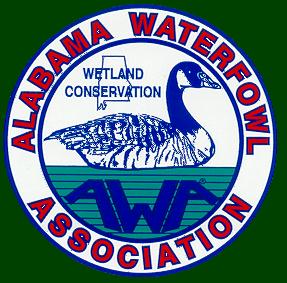-
- Alabama Waterfowl Association, Inc.
- 1346 COUNTY ROAD #11
- SCOTTSBORO, ALABAMA 35768
-
-
- According to the February 1999 issue of the National Geographic
Magazine the Cumberland and Tennessee Valley (including the Tennessee River Valley
Watershed) were cited as the world’s most diverse temperate freshwater ecosystems.
More and more non-point pollution is affecting our fresh water resource. The most
important part of filter banks, and other wetland functions will be conducive to
contributing to overall water quality in our human environment.
-
- The Tennessee River forms almost a horse shoe on its journey to
empty into the Ohio River, and is the only river in North America that runs both north and
south. The unique route of this river funnels migratory birds from both the Mississippi
Flyway and the Atlantic Flyway. The migratory birds depend on this ecosystem as both a
staging and over-wintering habitat. This is not to forget about all the plants, fish and
animals that depend on this critical watershed year round.
-
- In the United States we are losing habitat at a tremendous rate,
in 1996 it was estimated that over 92 million acres was taken out of farm, forest and
set-aside land and used for industrial, residential and road development. This is a huge
increase from 1982 with 14.5 million acres lost in that year. Also, as more
and more agriculture grains are being produced out of the United States, thus creating
lower prices, these low grain prices compounded by decreased supplement payments in the
1996 Farm Bill is driving the U. S. family farmers out of business. These family farm
operations are many times forced to sell the farm to developers, or subdividing land and
selling to individual homebuilders to pay their debts; this is especially true in the
Tennessee River Valley (TRV). The carbohydrates and protein from the left-over grain crops
are very important to our migrating over-wintering, and staging wildlife.
-
- The neo-tropical migrating songbirds have declined over 40 percent
or more. Habitat loss, especially areas of rapid urban development such as the TRV, are
thought to be the blame. This loss of habitat and grain production increases the problem
of providing beneficial food source, habitat and wetlands. (See Alabama Waterfowl
Association (AWA) Biologist Report. It is very important to have a good food and water
resource in the fall to furnish the over-flying migrating birds habitat to replenish their
energy for their journey on south.) This is also true on their migration back north in the
spring. If the migrating birds do not return to their breeding habitat in good condition,
they do not reproduce as well. This is why it is so important to have cropped wetlands and
water filter banks here in the TRV.
-
- The AWA would like to suggest that a water pumping system should
be added to the Alabama Wildlife Management Areas to assure moist soil for biodiversity
and also provide a staging area for the migrating shorebirds, neo-tropical migrants and
other waterfowl. The sensitive areas AWA has under contract and AWA’s Big Spring
Creek project needs to have sheet water and food available for the migrating birds. As you
are already aware, 1998 proved to be one of the driest years in the southeast. Also, many
of the birds that are migrating south in October and November need a food source to
continue their journey south. In November of 1998 I was in Arkansas’s rice belt where
in Poinsett, White and Craighead Counties over a million acres of waterfowl and shorebird
habitat is available and flooded mostly for waterfowl hunting season. In 1998 only 150,000
acres were available, and these acres had to be pumped because of the drought. Many of the
migrating birds over flew this area and I presume migrated on down to the Gulf Coastal
Region. I am sure they were under stress and short of energy. The same thing happened in
Alabama, many of the migrating shorebirds and waterfowl found a shortage of habitat in the
TRV. Normally most private waterfowl habitat managers would like to flood about two or
three weeks before duck season opens. This allows time for the ducks to find the habitat
and ensure that too many birds will not deplete the habitat’s food source. With duck
season opening in the second week of December and add to that the problem of the drought
(on most private habitat areas rainfall is only water source available for flooding), the
lack of food availability puts additional stress on already stressed migrating birds.
-
- It appears that the Earth is not going to stop growing; with the
population projection to be over 8 billion people by the year 2025. Is the Earth
going to reach our Biological Carrying Capacity (BCC), for wildlife and us humans, by all
the economic advancements in the Third World Countries? Are we humans smart enough
to compensate for all the pollution and the growing urban sprawl? Can we use an
antidote called sustainable development to combat the pollution and loss-of- habitat
problems?
- These and other conservation and pollution problems are what we
will be facing in the Twenty First Century.
-
- Please join with AWA, and start today, conserving the next
generation's tomorrow.
- JERRY D. DAVIS
- CEO

